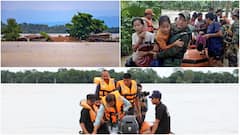In Flood-Prone Assam, Centre And IIT Collaborate To Devise Erosion-Prevention Model
Ongoing research at IIT-Guwahati continues to evolve the ‘BRAHMA-2D’ model, extending its application to estimate velocity changes for different vegetation types.

Researchers at the Indian Institute of Technology, Guwahati (IIT-Guwahati), in collaboration with the Union Ministry of Jal Shakti’s Brahmaputra Board, which plans and implements measures for flood control and bank erosion in Assam’s Brahmaputra and Barak Valley, have developed an indigenous river model called ‘BRAHMA-2D’ (Braided River Aid: Hydro-Morphological Analyzer). This model is likely to help Assam tackle the serious problem of river erosion.
The comprehensive mathematical model can help understand the flow of large braided rivers like the Brahmaputra, providing valuable insights to field engineers for designing sustainable hydraulic structures such as spurs, revetment, and other river bank protection measures. Predicting river flow variations across depth is crucial for flood and erosion control, agriculture, water supply intake design, and zero-head energy production, as stated in a press release by IIT-Guwahati.
Traditional measurement methods of flow velocity in deep, large rivers during high monsoons are risky and extremely difficult, prompting the use of mathematical models. The existing models provide only average velocity, underestimating undercurrents at different depths. In braided rivers, the presence of sandbars further complicates accurate three-dimensional velocity computation, according to the release.
Speaking about the ‘BRAHMA-2D’ model, Professor Arup Kumar Sarma of the Department of Civil Engineering, IIT Guwahati, who led the research team, said, “Our mathematical model combines highly complex mathematical modelling with challenging field-based research on large braided rivers. With this quasi-3D river flow model, we can understand how fast the water moves at different depths inside a river and its circulation around a structure like a spur installed for preventing river bank erosion.”
‘BRAHMA-2D’ integrates a two-dimensional model of water movement with a theory about entropy and a measure of disorder or randomness. The research also delves into how features like river banks, spurs, and sandbars affect the way water moves. Specifically, it observes a dip phenomenon near spurs where the flow of water underneath increases—a phenomenon absent in points away from these structures. The model was successfully validated on the Brahmaputra river near Assam’s Majuli island, the second-largest freshwater river island in the world, which is prone to river bank erosion, the release said.
Dr. Anupal Baruah, currently working as a post-doctoral fellow at the University of Alabama in the USA, highlighted the model’s successful application with river survey data, using Global Positioning System (GPS) Echo-Sounder for depth and Acoustic Doppler Current Profiler, along with current meters for velocity measurement. “During my research at IIT-Guwahati, field measurements near the spurs revealed a strong agreement with our model results. This breakthrough can now be applied to compute the vertical velocity profile at any desired location,” Baruah said.
Ongoing research at IIT-Guwahati continues to evolve the ‘BRAHMA-2D’ model, extending its application to estimate velocity changes for different vegetation types and assess the impact of structures like porcupines on flow velocity. The versatile model has further helped design bioengineering methods for controlling river bank erosion. It has also been applied to understand the habitat suitability of aquatic species, especially endangered species, based on the availability of required depth and flow velocity, as added in the release.
The release further said that the novel findings were published in the ISH Journal of Hydraulic Engineering, earning the paper the prestigious ‘ISH Jal Vigyan Puraskar’ (Best Paper in ISH Journal), 2023. The award ceremony took place on Thursday (December 21) this year, at the Hydro-2023 conference hosted at the National Institute of Technology (NIT) in Telangana’s Warangal.
According to the Assam Water Resources Department, the state faces a major problem of bank erosion by the Brahmaputra and Barak rivers and their tributaries. Every year, the damages caused by erosion in Assam run into several hundred crores. Bank erosion by these rivers has posed a serious threat for the past six decades, as land measuring over 4.27 lakh hectares has been eroded, which equals 7.40 per cent of Assam’s total area. According to an assessment, the annual average loss of land in Assam is nearly 8,000 hectares. Due to bank erosion, the width of the Brahmaputra River has increased up to 15 kilometres at some places. The surveys being carried out reflect an alarming scenario regarding the widening of the Brahmaputra river.
Related Video
Breaking: Dehradun Student Murder Sparks Nationwide Outrage, Police Deny Racial Angle Amid FIR Contradictions






































